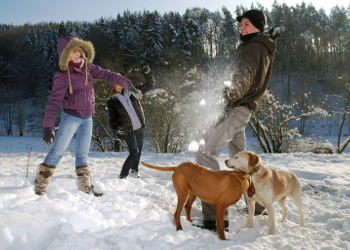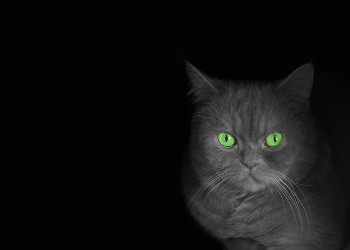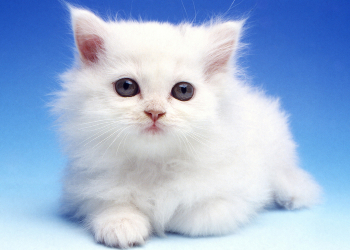Diseases #9

The conjuntiva is essential protective tissue that protects and covers the globe of the eye and the inner surface of the third eyelid. Inflammation of this tissue is caused conjunctivitis. Conjunctivitis can be either bulbar or palpebral in origin. The causes of conjunctivitis are varied. Bacterial, viral, foreign bodies, allergic irritants, secondary to glaucoma, trauma, and deficiency in tear production are just some of the more common causes of the disease in dogs and cats.
Animals may develop conjunctivitis secondary to a primary disease. Canine upper respiratory disease is one. In cats, it may be secondary to rhinotracheitis and calicivirus infections.
Excessive eyelid hair poking the eye surface and the conjunctiva can cause inflammation of the tissues. This condition is known as entropion. It is seen in English Bulldogs and other breeds that have loose periocular skin.
When some agent irritates the conjunctiva the tissue becomes inflamed and is often beet red. This inflammation causes intense eye pain. Depending upon the actual cause, conjunctivitis left untreated can damage the rest of the eye structure.
Conjunctivitis can occur only in one eye or simultaneously in both eyes at the same time. Trauma and or irritant based conjunctivitis usually occurs only in the affected eye while bacterial and viral conjunctivitis usually affects both eyes at the same time. The animal usually squints since the eye is extremely sensitive to light exposure. It is very painful. There is a muco-purulent discharge from the eye. The structure of the globe may look blood shot. The tissues of the eyelid (palpebral) conjunctiva are swollen and dark red. Because this is painful, dogs and cats may rub their face on the floor or try to use their paw to rub the eye. They may also be off their food because it hurts so much.
Conjunctivitis does not often exist on its own. It is important to perform a fluorescein strip test to rule out corneal ulcers as well as a tonometer exam to rule out glaucoma. A complete opthalomoscopic exam is performed to visualize the structures of the eye.
A diagnosis of conjunctivitis is made by the history, physical exam and laboratory findings.
Treatment of conjunctivitis is geared at treating the primary cause and providing relief for the affected eye. If the cause is bacterial or viral oral antibiotics may be prescribed as well as a topical antibiotic such as neomycin, polymyxin, and bacitracin. If the conjunctiva is inflamed and there are no corneal ulcers present, topical eye ointments may be prescribed with a corticosteroid present to provide pain and inflammatory relief. Excessive ocular pain may also be controlled with 1% atropine opthalmic ointment. Primary causes of corneal ulcers and glaucoma are also treated, if present. Animals with dry eye may need tear supplementation plus topical cyclosporine drops. Animals with entropion may need corrective surgery.
The prognosis for conjunctivitis is excellent as long as it is diagnosed and treated early, as well as trying to treat the primary cause of the disease. Most animals should be kept out of direct sunlight as it is extremely painful.




Coronavirus is a highly contagious virus seen in dogs and cats. There are several serotypes known. The virus in dogs is accociated with a yellow, green colored diarrhea. It is often misdiagnosed as parvo virus. In cats, the intestinal version exists and serologically very difficult to differentiate it from the coronavirus that causes Feline Infectious Peritonitis.
The canine coronavirus replicates in the upper gastrointestinal system. Cellular death leads to the clinical signs of diarrhea. This disease is much less severe than Parvo Virus in dogs. Cornonavirus has a high morbidity rate (highly contagious) yet it has a very low mortality rate.
Although the disease is highly contagious, many dogs with coronavirus do not even show any clinical signs. Maybe lethargy or a brief loss of appetite but nothing more. Other animals will have a green/yellow diarrhea. The animals that are injured the worst are young puppies that, at that point, do not have a mature immune system to fight off the disease. Animals with Parvo Virus and Coronavirus are dragged down even farther by having a mixed infection.
Many intestinal diseases are handled in a similar fashion. A CBC and Chemistry profile may be run to check organ function as well as a urinalysis. A fecal check is extremely important as parasites will prolong or exacerbate a dog trying to recover from Coronavirus.
Diagnosis is made by the history and clinical signs. Often it is difficult to get an exact diagnosis. This is not problematic since therapy overlaps a lot on many viral enteritis cases. Lab tests do exist that can check the antibody titer to canine coronavirus.
Many dogs are asymptomatic and or have a basic case and do not require any treatment at all. Their immune system resolves everything. Weakened young animals may need fluids and aminopentamide to rehydrate and control diarrhea. An appropriate wormer is given orally for intestinal parasite control. Antibiotics may be used to minimize the chance of developing secondary bacterial intestinal diseases. Dietary management may entail hamburger and rice at a ratio of 1:3 or the owner may purchase Hill's® Prescription Diet Canine i/d. Fluid therapy consisting of a sports drink or ice cubes made of the same will help replenish lost electrolytes.
The prognosis for the majority of coronavirus cases is excellent. It has a very low mortality rate. Weakened puppies with coronavirus that are severely dehydrated are at a greater risk of not surviving.




The cruciate ligaments are a part of the most complex joint in the mammalian body, the knee! These two ligaments, one cranial and the other caudal cross to support the tibia (the bone below the thigh bone) and prevent it from twisting. It keeps the knee in place and prevents excess extension of the knee joint. The most common cause of cruciate damage is acute trauma. Car Accidents and falling down stairs are some trauma causes. Other causes are chronic. These injuries occur over time and can than cause clinical signs of cruciate damage. Obesity is also a factor in cruciate damage.
When the support of the cruciate ligaments falter, pain and arthritis become a problem. Cruciate ligament disease can be partial or complete. In veterinary medicine, the anterior cruciate ligament is torn much more commonly than the posterior ligament. It can occur in any dog but is predisposed to young to middle aged active big dogs. Those animals that are obese are at further risk. In chronic cases, the cruciate damage occurs over time. The ligament stretches and relaxes, than reaches a breaking point and ruptures completely. This is seen in dogs a bit older than the acute form and it is usually presented in both hind limbs.
The most common clinical sign in dogs is lameness in the affected hind limb. It can be painful. The joint may feel warm and inflamed also.
The knee is a complex joint so it is prudent to radiograph and or ultrasound the knee joint to make sure there are no other causes of the lameness in the joint such as fracture of the tibial crest. Radiographs can not show the ligaments but will show the anatomical placement of the bones forming the knee joint. Ultrasound will show the cruciate ligaments so it can provide a definitive diagnosis of cruciate disease.
Diagnosis of cruciate disease starts by obtaining a history. Has the dog jumped and came down wrong? Has there been some other type of trauma? A physical exam is crucial. There are two tests veterinarians use. One is the drawer response. The femur is held with one hand and the tibia is moved forward like a drawer. If this motion occurs, it is positive for cruciate disease. In the tibial compression test, the femur is held in one hand and the ankle of the dog is flexed. If there is any movement of the tibia, there is probable cruciate disease. That physical is than combined with findings from an ultrasound test to make the diagnosis.
Treatment is geared towards stabilizing the knee joint. This is accomplished by medical and or surgical care. In little dogs under 30 pounds many will do with conservative care. This includes rest, anti-inflammatory drugs such as Rimadyl®, physical therapy such as swimming plus a weight control program if the dog is overweight. Surgical correction should be performed by a board certified orthopedic veterinarian. It is the treatment of choice for bigger dogs. One of the most favored surgical techniques is TPLO; a tibial planing procedure. Grafts are used in human ACL issues but not so in dogs. It is the vector forces in the canine knee that causes problems. Controlling those forces is what the TPLO attempts to do. A cut is made and the tibia is rotated so as to be about 90 degrees to the attachment of the quadricepts attachment. Post operative care is ultra important. The dog has to have its activity restricted for at least 2-3 months. Walks can be done but only on a leash and the animal should be crated or kept in a small room while owners are away.
The prognosis for cruciate disease is good as long as it is promptly diagnosed and treated. Dogs with concurrent arthritis may take longer to achieve success. Owners must follow an exact treatment and post operative plan such as physical therapy and weight control, if needed. It may be difficult but the animal can injure the joint again if the same level of activity is maintained post operatively. Arthritis may continue to advance but the dog is better off after having had a TPLO procedure.




A cyst is any hollow space in any tissue that has a fluid mass in the center. True cysts will have a secretory layer known as the cyst wall. Cysts can be classified into: true, false, follicular or sebaceous cysts. The cause of cysts is varied. In follicular cysts localized infection and irritation of the hair follicles can cause a cyst. Comedomes are another type of cysts seen in Miniature Schnauzers with Cushing's Syndrome. Other cysts may be congenital in origin or form out of faulty glandular secretions.
In follicular cysts localized infection and irritation of the hair follicles can cause a cyst. Other cysts may be congenital in origin or form out of faulty glandular secretions. Cysts can occur anywhere on the dog or cat body. A cyst may take on the behavior in the anatomical area of the body it is located. Cysts located on the nostril will often be pigmented and contain a dark pigmented secretion. The discussion here is only on non-cancerous lesions. Many of these cysts themselves can become further infected. Up north in cold weather, anything above the skin surface may firm and than ulcerate. This causes the animal to lick the area and bite at it.
Various growths may occur on any animal. These growths are usually round and may have abnormal surface areas. Some growths like comedomes are noticing in dogs demonstrating signs of Cushing's Syndrome. Otherwise very few signs are seen. Some may be indirect such as a dog or cat licking a certain part of the body.
A CBC and Chemistry Profile are completed to assure safety during the surgical anesthetic procedure.
Diagnosis is made by observing a cyst like growth on a dog or cat. A veterinarian may try to aspirate cells or fluid from the cyst to observe under a microscope to help point him or her in the right direction.
Treatment is usually surgical. This may be done with a scalpel or laser surgery. Sometimes, the cyst may disappear or even fall off hence no further treatment is needed. The cyst is excised and usually sent to a lab for a histopathological diagnosis. It is this diagnosis that is the important one. A cyst may "look" like a cyst but may be something totally different to a pathologist. Sutures or medical glue is applied to close the wound. Astringents may work in some cases. Owners can try those first if they wish, than surgery if that fails.
If the primary cause of the issue is a cyst, surgical excision of it produces an excellent prognosis. Cysts associated with an endocrine disease are different. The cyst may be successfully removed but the dogs prognosis is tied to the primary medical condition.




Cystitis is defined as an inflammation of the urinary bladder in the dog. Cystitis is most commonly seen in female animals and is usually caused by a bacterial or mixed bacterial infection. E. coli, Pseudomonas aeringinosa and Staphylococcus sp are common causes of cystitis (also referred to as an UTI). It may also be caused by taking corticosteroids. This can occur also in Cushing's Syndrome where there is excess cortisol produced by the adrenal glands. Bladder stones also can exacerbate a UTI. In intact males, prostate problems can also predispose the animal to cystitis. Diabetic patients are also more prone to developing cystitis.
Male animals are less prone at getting cystitis. One of the main reasons is the "huge" distance from the exterior urethral orifice (tip of the penis) to the bladder. This distance prevents many infections. In females, the urethra is very short. Infections are usually called "ascending infections" since the bacteria creep up the external urethral orifice from the vagina to the bladder. This is a very short distance.
Urine is composed of soluble waste materials and water. Bacteria such as Escherichia coli will "split" urea into its separate components. Urea is the waste product of protein metabolism and is manufactured in the liver and secreted into the urine. The split produces ammonia. Ammonia is alkaline therefore raising the pH of urine to over 7. Urine is normally slightly acidic. This favors bacterial reproduction and certain minerals can come out of solution to form crystals; most commonly- struvite, oxalate or urate.
The most commonly seen clinical signs in dogs are: urinating blood (hematuria), straining to urinate (estranguria) and the desire to frequently urinate (pollakiuria). Owners will often let their dog outside and watch it squat to urinate every few seconds or so. The animal may than come inside and urinate on the floor. If urinary crystals are present, they have very sharp edges and poke the lining of the bladder. Cystitis hurts and a dog may frequently lick the vulvar or perineal region in an attempt to alleviate the discomfort. There may also be a foul smelling vaginal discharge secondary to the infection.
A CBC and Chemistry profile are always performed to rule out any general (systemic) medical cause of urinating behavior such as Diabetes mellitus and Cushing's Syndrome. These are easily differentiated from straight urinary tract infections. A urinalysis is always performed. The liquid is tested to check the pH of the urine and the presence of non visual blood. The sample is spun down and than placed on a microscope slide to look for sturvite or oxalate crystals in the urine. To determine the bacterial cause of the cystitis, a culture of the urine is done by an outside lab. If bladder stones are detected, the best way to visualize them is by ultrasound or a lateral and ventral radiograph of the lower abdomen. If there are no bacteria or stones present, yet signs of cystitis persist the veterinarian will perform a contrast study of the bladder. A common technique is called a pneumocystogram where air serves as the contrast media when injected into the bladder. Diverticulum (a small pouch off-shoot within a hollow structure) and other causes of cystitis may be found. Hypaque® is also used for the same function.
Diagnosis is made by obtaining a medical history of the usual owner complaints such as: frequent urination, straining to urinate and wanting to urinate more frequently. A physical exam is performed and the bladder is palpated. Many times veterinarians can palpate bladder stones making things much easier to figure out. Combining these findings with all pertinent lab data easily makes the diagnosis.
As with most things in medicine, treatment of cystitis is based upon the primary cause of the condition in the dog. Diabetes mellitus and Cushing's Syndrome has to be treated to gain any traction on a urinary tract infection. If bladder stones are found they will have to be dealt with surgically or special stone dissolving diets. In a bacterial cystitis, antibiotics are prescribed for at least 2 weeks. One of the big failures in treating a UTI is insufficient time on antibiotics. This produces a recurrent infection or even a mixed bacterial infection. A recurrent infection has the same bacteria as before. They just weren't killed by long enough time on antibiotics. Mixed infections are those with several types of bacteria present. If one set of antibiotics do not work, a culture will be done to figure out which one will work.
Adding a small amount of cranberry juice at home will acidify the urine making control easier. The dog should be encouraged to drink plenty of water. This will help to rinse out as much material in the bladder as possible. This is also accomplished by letting the dog out to urinate even if it doesn't have to go. Just by emptying as much of the urine in the bladder helps treat and control future episodes of cystitis.
What is important is dietary control. Special diets have been formulated that are restricted in ash content; particularly magnesium. Increased amount of sodium are included to make the animal drink more water. These diets are extremely effective in treating and preventing UTI's in dogs. A prime example is Hill's Prescription Diet Canine c/d. Even when this therapy has been followed it is crucial that owners take a urine sample to the medical office. Repeat urinalysis' are an important diagnostic tool used to spot infections before clinical signs are noticed. Collecting a urine sample is easy. First thing in the morning, put the dog on a leash and go outside with a small paper plate and stick it under the dog when she squats to urinate. Medical offices only need about a tablespoon. If the dog goes on the floor, use an eyedropper and put it into a clean container. Since cultures will not be taken from either technique, refrigeration is not necessary.
Prognosis for most bladder infections is good with rapid diagnosis, treatment and follow up care. Prognosis of systemic diseases is most important when dealing with secondary bladder infections. Some animals are very difficult to treat and have many recurrent infections. Keeping animals on antibiotics forever does not work as veterinarians will than be dealing with antibiotic resistant infections. Chronic bladder infections have a thick bladder wall which means a smaller cavity for urine collection plus decreased contractability of the detrusor muscle. Urine that should go outside during micturition (urination) stays inside making the UTI worse. The management of these cases can be difficult.

